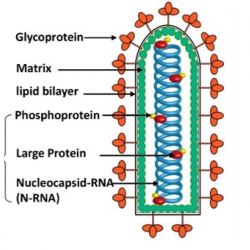
It isn't often when an invention that changes the landscape comes along. But one just did.
A new paper in the British journal The Lancet, which had 30 authors, reports results that seem too good to be true.
But they are not. A group led by the World Health Organization using a vaccine that was invented in Canada conducted a large scale inoculation in Guinea and Sierra Leone to assess how well it protected people against Ebola—the virus that ravaged Africa in 2014, killing 60 percent of the people that it infected. How well did it work? Spectacularly. The vaccine protected 100 percent of the people who received it. This is the first and only therapy for Ebola, other than prior supportive measures such as rehydration.
The vaccine, which is a glycoprotein (1) called rVSV-ZEBOV, was tested in Guinea and Sierra Leone. The group gathered samples from an individual, either alive or dead who had a positive lab test for Ebola, and then identified a cluster of their contacts, contacts of the contacts, and the contacts of the contacts who weren't around when the team arrived. Each uninfected person got a single injection of the vaccine in the arm. The results are stunning.
The group identified a total of 4539 people in 51 clusters between March 2015, and January 2016. About half (2119 people) received the vaccine immediately, and another 2041 got it 21 days later.
"Vaccine efficacy was 100% (95% CI 68·9–100·0, p=0·0045)"
Ana Maria Henao-Restrepo, M.D. et al, The Lancet, December 22, 2016
rVSV-ZEBOV had previously been shown to protect mice, guinea pigs and primates against a challenge from the virus. Since animal models of infection tend to be very good (predictive of efficacy in humans), it would have been unusual for rVSV-ZEBOV to fail entirely, but even more so for it to succeed so spectacularly (3).
The name of the vaccine sounds daunting, but it's really not. The "r" means recombinant—formed by alteration of viral DNA, which can be done using standard molecular biotechnology techniques. VSV stands for vesicular stomatitis virus—the virus that was modified (2). ZEBOV is short for Zaire Ebola virus, which was the most deadly circulating strain.

The structure of the vesicular stomatitis virus. Source: InTech
The safety profile of rVSV-ZEBOV was also excellent. A total of 80 adverse effects were identified, the most common (39) being Ebola disease itself (3). Only two adverse effects were attributed to the vaccine itself—one case of anaphylaxis and one fever.
By any measure, rVSV-ZEBOV is a huge achievement—one that could rid the world of a very scary, deadly disease. If this doesn't demonstrate the power of vaccination, then nothing does. Parents who fail to vaccinate their children should pay attention.
Notes:
(1) Glycoproteins are proteins with sugars attached, which help the protein to bind to its target.
(2) VSV is a rhabdovirus. (Rhabdo is Greek for rod-shaped.) Also in this family is Rabies lyssavirus, the virus that causes rabies.
(3) Although the vaccine did prevent infection in all people who received it, the overall protection rate for all study participants was 70 percent. The authors attribute this difference to the fact that only 52 percent of the contacts and contacts of contacts were vaccinated.
Original source: Henaro-Restrepo et al "Efficacy and effectiveness of an rVSV-vectored vaccine in preventing Ebola virus disease: final results from the Guinea ring vaccination, open-label, cluster-randomised trial (Ebola Ça Suffit!)" The Lancet (2016) Volume 388, Online First.
